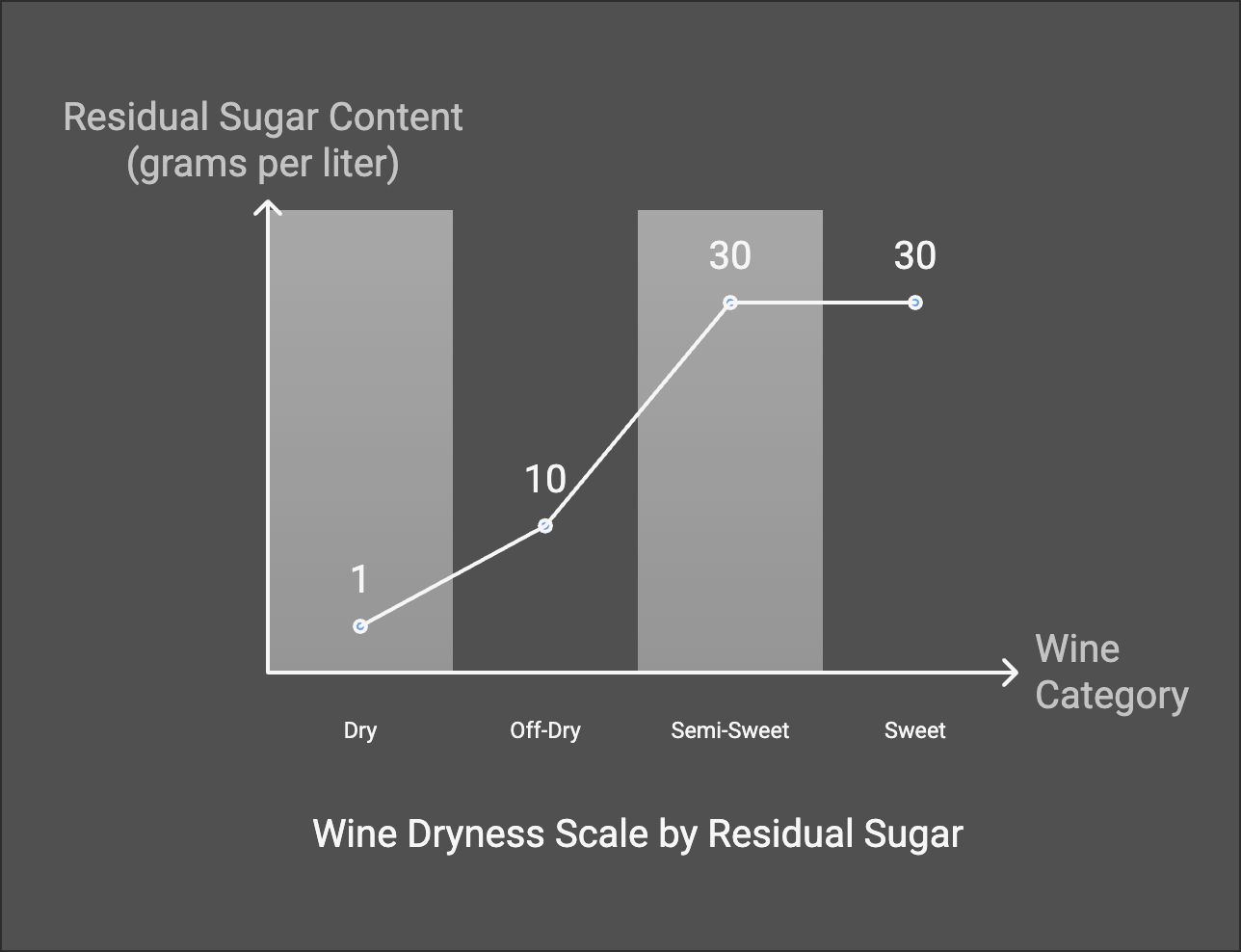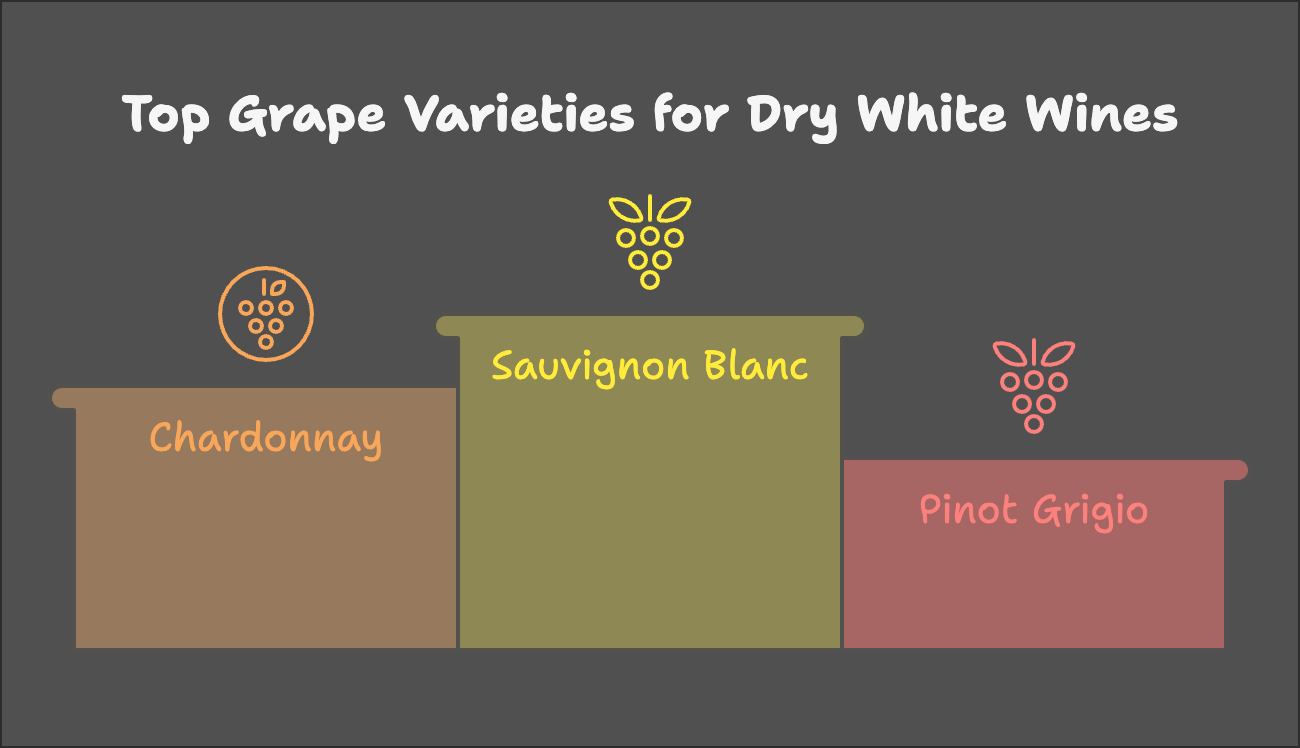The Ultimate Wine Sweetness Chart Explained
Understanding wine sweetness levels with charts can elevate your appreciation for this beloved beverage, whether you're a sommelier or a budding wine enthusiast.
This guide will unravel the complexity of wine sweetness, providing you with an easy-to-understand chart and recommendations for each category.
The sweetness of a wine is primarily determined by the amount of residual sugar it contains after fermentation. This can range from no perceptible sweetness, known as 'dry,' to very noticeable sweetness, referred to as 'sweet' or 'dessert' wines. Wine sweetness can dramatically affect the wine's taste and is a key factor when pairing wines with food.
The Wine Sweetness Chart
We've created an easy-to-reference wine sweetness chart to understand the spectrum of wine sweetness. This chart categorizes wines from 'dry' to 'very sweet'’ providing a guide to navigating the world of wine.
Bone-Dry Wines
Bone-dry white wines are characterized by their minimal residual sugar content, typically less than 1 gram per liter, resulting in a crisp and refreshing taste. Here are some notable grape varieties that produce such wines:
Assyrtiko
Originating from the volcanic soils of Santorini, Greece, Assyrtiko wines are renowned for their high acidity and mineral-driven profiles, often exhibiting citrus and stone fruit flavors.
Melon de Bourgogne (Muscadet)
Hailing from the Loire Valley in France, this grape produces light-bodied, bone-dry wines with crisp acidity and subtle notes of green apple and lime, making them excellent companions to seafood dishes.
Sauvignon Blanc
Cultivated in regions like the Loire Valley and Bordeaux in France, as well as New Zealand, Sauvignon Blanc yields dry wines with vibrant acidity and flavors ranging from green apple and citrus to herbaceous notes.
Grüner Veltliner
Austria's flagship white grape, Grüner Veltliner, is known for producing dry wines with high acidity, featuring flavors of green apple, citrus, and a distinctive white pepper spice.
Albariño
Predominantly grown in Spain's Rías Baixas region, Albariño wines are typically bone-dry, showcasing high acidity and notes of lemon, lime, and peach, often with a saline minerality.
Please note that while this chart follows your instructions, wine flavors can vary significantly depending on the specific region, vintage, and wine-making process. These descriptions are generalizations, and individual wines of these types may not align perfectly with these descriptors.
Dry Wines
Dry wines, which come just after bone-dry on the wine sweetness chart, have minimal residual sugar, typically less than 4g/L. They offer crisp, refreshing, or bold flavors with only a hint of sweetness, if any. From the zesty citrus of white wines like Sauvignon Blanc to the structured tannins of red wines like Cabernet Sauvignon, dry wines also include delicate Rosés and elegant Sparkling styles like Brut Champagne. These versatile wines are ideal for food pairings and loved for their clean, balanced taste.
Comparison of Dry Wines by Type: White, Red, Rosé, and Sparkling
White Dry Wines
Residual Sugar: Typically <4g/L.
Grape Varieties: Sauvignon Blanc, Chardonnay, Pinot Grigio, Albariño.
Key Characteristics: Crisp acidity, citrus and green apple flavors, with mineral or herbaceous notes.
Examples: Sancerre (Sauvignon Blanc), Chablis (Chardonnay), Italian Pinot Grigio.
Red Dry Wines
Residual Sugar: Typically <4g/L.
Grape Varieties: Cabernet Sauvignon, Syrah/Shiraz, Tempranillo, Pinot Noir.
Key Characteristics: Bold tannins, dark fruit flavors (blackberry, cherry), with earthy or spicy undertones.
Examples: Bordeaux (Cabernet Sauvignon), Rioja (Tempranillo), Barolo (Nebbiolo).
Rosé Dry Wines
Residual Sugar: Typically <4g/L.
Grape Varieties: Grenache, Syrah, Mourvèdre, Pinot Noir.
Key Characteristics: Light-bodied, red berry and citrus flavors, with refreshing acidity.
Examples: Provence Rosé, Tavel Rosé (Grenache-based).
Sparkling Dry Wines
Residual Sugar: Brut or Extra Brut styles contain <12g/L.
Grape Varieties: Chardonnay, Pinot Noir, Pinot Meunier.
Key Characteristics: High acidity, crisp apple, citrus, and toasty or yeasty notes.
Examples: Champagne (Brut), Cava, Franciacorta.
Dry wines across all types share a common feature of low residual sugar, making them versatile for food pairings and appealing to those who prefer less sweetness.
Off-Dry
Off-dry wines sit slightly higher than dry wines on the sweetness chart, with residual sugar typically ranging between 5–12g/L. They offer a subtle touch of sweetness balanced by refreshing acidity, making them approachable and versatile. Common off-dry styles include white wines like Riesling and Chenin Blanc.
These wines pair wonderfully with spicy dishes or light desserts, offering a perfect balance between sweetness and flavor.
Key Grape Varieties and Wines for Off-Dry Styles
White Grapes and Wines
Riesling: Often off-dry in regions like Germany or Alsace, showcasing vibrant acidity with flavors of green apple, citrus, and stone fruit.
Chenin Blanc: Frequently off-dry in Vouvray (Loire Valley), offering notes of quince, pear, and honey balanced by refreshing acidity.
Gewürztraminer: Known for its aromatic profile with lychee, rose, and tropical fruit flavors, often off-dry in Alsace and Germany.
Pinot Gris (Alsace): Produces rich, off-dry wines with flavors of ripe peach, apricot, and a subtle spiciness, often fuller-bodied compared to other regions.
Red Grapes and Wines
Lambrusco: Some versions, especially from Emilia-Romagna, are off-dry, offering a lightly sparkling wine with red berry and cherry flavors.
Rosé Grapes and Wines
Rosé d’Anjou: A Loire Valley specialty, often made from Grolleau grapes, offering a lightly sweet rosé with red berry flavors and a refreshing finish.
Medium (or Semi-Sweet)
Medium-sweet wines, with residual sugar typically ranging from 12–45g/L, strike a balance between noticeable sweetness and refreshing acidity. These wines are versatile, complementing a wide range of foods, including spicy dishes, savory cheeses, and light desserts. Their approachable sweetness makes them popular for both casual sipping and pairing occasions.
Key Grape Varieties and Wines for Medium-Sweet Styles
White Grapes and Wines
Riesling: Medium-sweet examples are common in Germany’s Mosel region, showcasing flavors of honey, apricot, and lime with vibrant acidity.
Chenin Blanc: Often medium-sweet in Loire Valley’s Coteaux du Layon, offering notes of baked apple, quince, and floral honey.
Red Grapes and Wines
Brachetto: From Piedmont, Italy, this light, aromatic red wine has medium sweetness with flavors of strawberry, raspberry, and rose petals.
Rosé Grapes and Wines
White Zinfandel: A medium-sweet rosé from California, featuring strawberry, watermelon, and citrus flavors with a soft finish.
Sparkling Grapes and Wines
Asti Spumante: A medium-sweet sparkling wine from Piedmont, Italy, made from Moscato grapes, offering flavors of peach, orange blossom, and honey.
Moscato d'Asti: A lightly sparkling, medium-sweet wine with similar flavors to Asti Spumante but lower alcohol.
Medium-sweet wines offer a delightful balance of sweetness and acidity, perfect for pairing with spicy Asian cuisine, tangy blue cheeses, or fruit-forward desserts like peach cobbler.
Sweet and Very Sweet
Sweet: 'Sweet' wines are rich in residual sugar and often have a lush, dessert-like flavor. They might be served with dessert or even as dessert themselves. They are sweet but still maintain a good balance with acidity. Moscato is a common example of sweet wine.
Very Sweet: 'Very sweet' wines, often dessert wines, have a high residual sugar level. They are often rich and opulent and are usually enjoyed in smaller amounts due to their intense sweetness.
Examples include Port, Sherry, and Sauternes.
Sweet:
Late Harvest Riesling (Germany)
Moscato (Italy)
Ruby Port (Portugal)
Sauternes (France; some can also be in the very sweet category)
Ice Wine (Canada)
Very Sweet:
Pedro Ximénez Sherry (Spain)
Tokaji Aszú 6 Puttonyos (Hungary, with 6 Puttonyos indicating a very high level of sweetness)
Trockenbeerenauslese Riesling (Germany)
Vintage Port (Portugal)
FAQs About Wine Sweetness
Does a sweeter wine mean it's of lower quality?
Absolutely not! The sweetness of a wine does not determine its quality. It's all about balance. A well-made sweet wine will balance sugar with acidity, so it doesn't taste cloyingly sweet.
Does sweet wine have more alcohol?
Not necessarily. The alcohol content in wine depends on the fermentation process, not the sweetness level.
Can you tell a wine's sweetness from the label?
Labels can give clues about a wine's sweetness. Some wines will explicitly state their sweetness level (like "dry," "off-dry," or "sweet"). In addition, wines from certain regions have traditional sweetness levels. For instance, wines labeled "Vouvray" from France can range from sweet to dry, but the label usually indicates which.
Do all red wines tend to be dry?
While many red wines are dry, not all are. There are sweeter red wines like Port, Brachetto d'Acqui, or Lambrusco. Some red wines can also have a perception of sweetness if they have high alcohol content or ripe fruit flavors, even if they are technically dry.
Does wine get sweeter as it ages?
Not necessarily. While the fruit flavors in the wine can become more concentrated with age, giving an impression of sweetness, the sugar content does not change with age. The sweetness of the wine is determined at the time of bottling.
What food pairs well with sweet wines?
Sweet wines are often paired with desserts because the sugar in the food and wine can complement each other. However, sweet wines can also pair beautifully with spicy foods, as the sweetness can help temper the heat.
Are sweet wines always white?
No, sweet wines can be either white or red. Many sweet wines, like Sauternes or Moscato, are white, but there are also sweet red wines like Port and some late-harvest reds.
Why do some people prefer sweet wines?
Sweetness is one of the basic tastes that humans generally enjoy. Additionally, sweet wines often have fruity, approachable flavors that can be appreciated even by those who aren't accustomed to drinking wine. However, like any aspect of wine, sweetness preference is highly individual and can vary greatly from person to person.
Conclusion
Understanding wine sweetness levels can help you make more informed decisions when choosing a bottle and can elevate your wine-tasting experience. We hope our wine sweetness chart serves as a valuable tool for exploring the world of wine.
Remember, wine tasting is subjective, and the best wine is the one that you enjoy!








